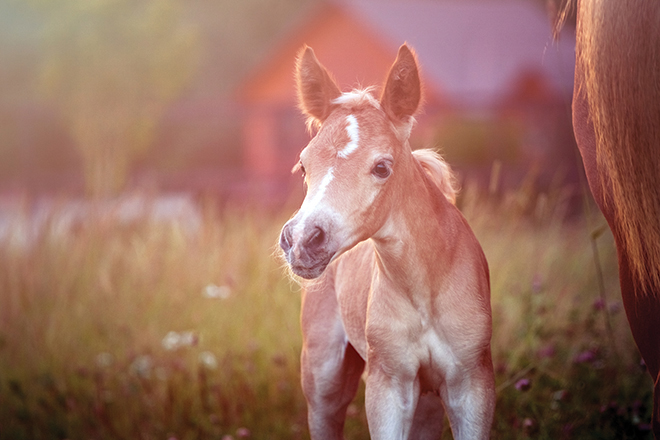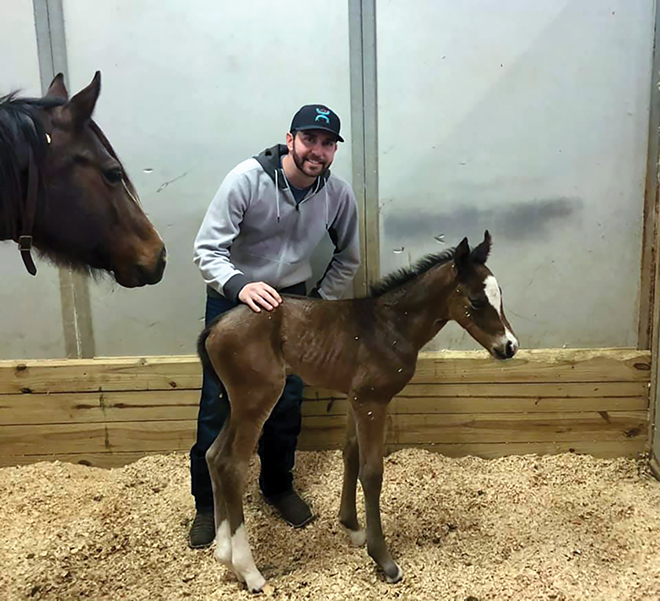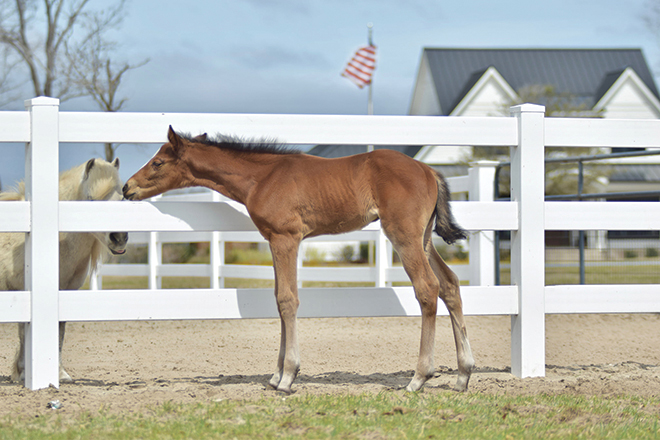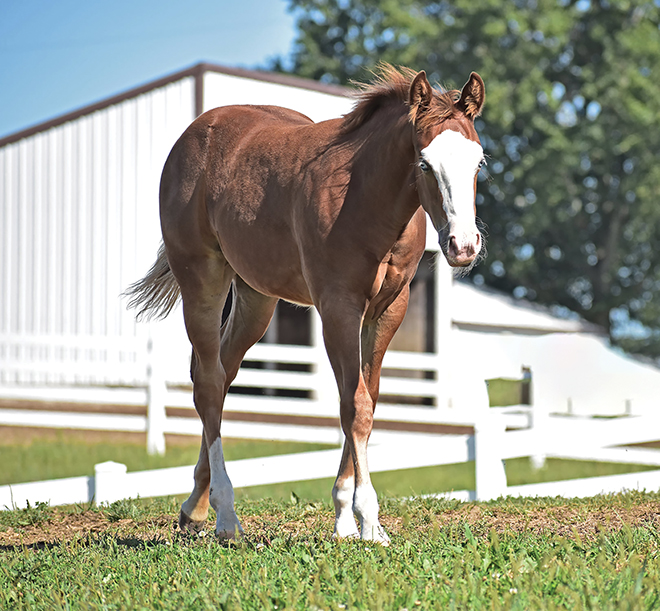
Nothing is cuter in the spring than Facebook feeds filled by foals. They’re just simply adorable and they carry the hope and promise of a bright future. From the moment a foal arrives, every experience contributes to their outlook on life and eventual trainability. Every breeder has a different approach, one works for their program and facilities.
Here’s a look behind the barn doors at how three of the industry’s breeders welcome their foals into the world and prepare them for life as a show horse.
Leier Performance Horses, Gordonville, Texas
Anthony Leier, owner
What is your approach to interacting with new foals?
We scratch on them for five to 10 minutes each day but we do not teach them to pick up their legs or lead. As long as they are friendly and unafraid of humans then we just let them be babies.
How do you raise your foals?
For the first two to three weeks of their life we keep them in stalls at night. This helps them get the hang of following mom around. It gives them time to get the hang of following her in and out of the barn for turnout.
After they get used to being out with mom we turn them out with another mare and foal for about a week. This introduces them to living with other horse without being in a large group. After that the mares and babies are turned out in groups of four to five. We’ve set up the place so that we have seven big pastures and shelters to raise them this way.
Why does this work for your program?
The foals are not feral they are not afraid of people but I feel like being hands off means they come in for training with less attitude and bad habits as a yearling. I like my horses my fresh, not wild, but a bit spicy when they come in. I’ve worked with horses that were handled from the time they were born, taught to lead at two days old and had their first farrier visit within a week. They develop habits and attitudes by then.
Advice for raising foals
Breeding is exciting, heartbreaking, happy and frustrating all at the same time. Never expect anything and be happy for what you do get as breeding and raising foals is not for the weak.
Capall Creek Farm LLC., Hampstead, North Carolina
Melanie Thurston, breeding manager
What is your approach to interacting with new foals?
We do not imprint them per se, but we are very hands-on with them from the time they are born. Besides the normal foaling protocols of making sure they drink a full bottle of colostrum and spraying the umbilicus with betadine two to three times a day, we also try to rub on them and spend time with them. We are what I like to call a “boutique breeding program” and have the luxury of only having four to six babies a year so ours get a lot of human interaction and snuggles.
How do you raise your foals?
We handle them daily until about two to three months of age when they get turned out in the big field with their moms. And then we wean them between five to six months of age, and they stay out in the field with their “friends.” Even while on turnout we are out there twice daily playing with them at feed time. Amy (Smith) and I try to go out once a week and watch them move and love on them. They also come in every four weeks for the farrier. Our program seems to work pretty well for us, and our foals all adjust to things rather quickly.
Why does this work for your program?
We feel that putting a good foundation on them at a young age makes it easier to handle them as yearlings and 2-year-olds. Along with their daily snuggles, our babies are all halter broke and are led in and out daily starting at three days old. Ours are usually friendly to a fault and don’t always understand the personal space bubble.
We try to just let them be babies as long as they can before they head off to “school.” We like to put older mares in with the babies. They do a better job “training” them and teaching them manners than we ever could. Our babysitter mares are worth their weight in gold for that.
Advice for raising foals
Try not to be too hard on yourself. We are all manipulating Mother Nature, and sometimes there is no answer as to why it doesn’t work out. You must also recognize the signs of a distressed foal because they can crash quickly. It’s critical to stay on top of them in that first 24-48 hours and watch for excessive tail flagging, rolling onto their backs, and excessive bumping at mom while nursing.
I also think that people should stay on top of their growth when they are young to try and alleviate issues when they get older. We are very aggressive with farrier care when they are young and will trim them every four weeks and put heel or toe extensions on as needed to help strengthen and straighten any issues while their bones are still relatively soft and malleable.
We also try not to let our babies get too chunky, especially our hunt-seaters while growing so that we don’t put too much extra weight on their growth plates. Trust your gut and do what you think is right.
Leeman farm, Massilon, Ohio
Lauren Erk, breeding manager
What is your approach to interacting with new foals?
When our foals are first born, we make sure that they pass the meconium, stand unassisted and nurse. We don’t “imprint” them as some people do. We do not expose them to clippers, spray bottles, and such. We assist the foals in standing and finding where the mares bag is for nursing, but we do not interfere with the mare bonding with her baby.
How do you raise your foals?
Typically, we leave the new foal and mare in the stall for the first day after being born. Weather permitting, they are turned outside in an individual pen for a few hours the first day or two, and then they can stay out all day- again weather permitting rain/snow/cold wind.
We put halters on the foals right away and lead them around with butt ropes the first few days before transitioning to leading by the halter. After a few days, the foals are used to us walking by them, walking next to the mare, and giving to pressure to the butt rope. That makes the transition seamless to taking the butt rope away.
After a day or two of the babies leading normally we introduce them to a larger pasture turnout area and introduce two new pairs at a time. This gives the mares and foals plenty of space to stay away from the other if they want to. With only two new pairs out together if the babies happen to swap moms by accident it is easy for them to get reacquainted with their correct mom after a bit of time.
How do your foals spend their day?
Mares and babies are turned out every day and left out from 8 a.m. to 3 p.m. If the weather is bad we turn them out while stalls are cleaned to get fresh air. We bring them back in once stalls are bedded.
Babies can start living outside once it stays around 40 at night. Depending on which pasture they will be living in dictates the number of pairs living in each one. We typically have around six to eight in a given pasture, mainly dependent on the size of the shed the pastures have so that there is enough room so they all can get in out of the weather.
Why does this work for your program?
We instill basic manners and respect in our babies, but we don’t want to teach them bad habits from overstimulation. Our babies/weanlings are halter broke and broke to lead, but we leave their slate clean after that.
By keeping what we teach them to a minimum allows us to not put any bad habits on them, and do not get them sour to learning things when they are supposed to as yearlings in training. This also keeps them happy and interested in humans at the same time teaching them not to be standoffish. They are babies and can only handle so much with limited time of processing what you are trying to teach them.
We have the stall space to accommodate the foals we have, but fresh air and grass are so much better for them to grow up on and lessens any respiratory issues that may arise.
Advice for raising foals
The biggest thing, if possible, is to let them grow up with other babies and mares. They will learn respect and the pecking order, which will help translate over when owners or trainers start working with them. Sometimes over imprinting can result in a loss of respect to people. Being pushy only gets worse as they get bigger due to their size.





You must be logged in to post a comment Login